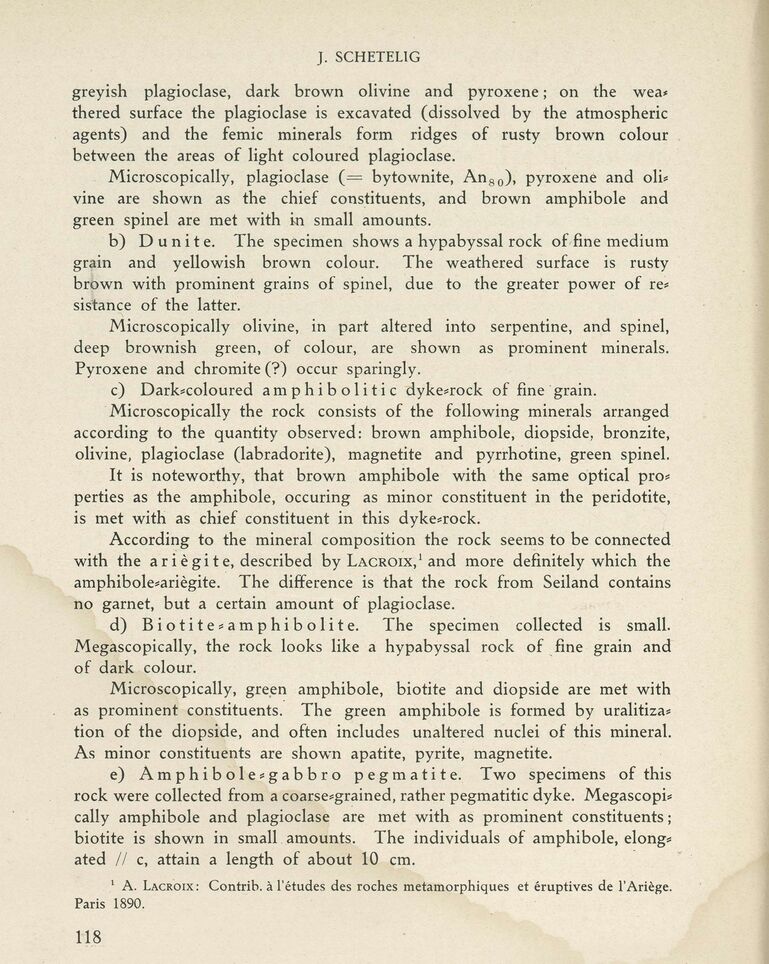
Full resolution (JPEG) - On this page / på denna sida - Sidor ...

<< prev. page << föreg. sida << >> nästa sida >> next page >>
Below is the raw OCR text
from the above scanned image.
Do you see an error? Proofread the page now!
Här nedan syns maskintolkade texten från faksimilbilden ovan.
Ser du något fel? Korrekturläs sidan nu!
This page has never been proofread. / Denna sida har aldrig korrekturlästs.
J. SCHETELIG
greyish plagioclase, dark brown olivine and pyroxene; on the wea*
thered surface the plagioclase is excavated (dissolved by the atmospheric
agents) and the femic minerals form ridges of rusty brown colour
between the areas of light coloured plagioclase.
Microscopically, plagioclase (= bytownite, Anao), pyroxene and oli»
vine are shown as the chief constituents, and brown amphibole and
green spinel are met with in small amounts.
b) D unite. The specimen shows a hypabyssal rock of fine medium
grain and yellowish brown colour. The weathered surface is rusty
brown with prominent grains of spinel, due to the greater power of re=
sistance of the latter.
Microscopically olivine, in part altered into serpentine, and spinel,
deep brownish green, of colour, are shown as prominent minerals.
Pyroxene and chromite (?) occur sparingly.
c) Dark=coloured amphibolitic dyke*rock of fine grain.
Microscopically the rock consists of the following minerals arranged
according to the quantity observed: brown amphibole, diopside, bronzite,
olivine, plagioclase (labradorite), magnetite and pyrrhotine, green spinel.
It is noteworthy, that brown amphibole with the same optical pro*
perties as the amphibole, occuring as minor constituent in the peridotite,
is met with as chief constituent in this dyke*rock.
According to the mineral composition the rock seems to be connected
with the a r i é gi t e, described by Lacroix,1 and more definitely which the
amphibole*ariégite. The difference is that the rock from Seiland contains
no garnet, but a certain amount of plagioclase.
d) Biotitesamphibolite. The specimen collected is small.
Megascopically, the rock looks like a hypabyssal rock of fine grain and
of dark colour.
Microscopically, green amphibole, biotite and diopside are met with
as prominent constituents. The green amphibole is formed by uralitiza«
tion of the diopside, and often includes unaltered nuclei of this mineral.
As minor constituents are shown apatite, pyrite, magnetite.
e) Amphibole = gabbro pegmatite. Two specimens of this
rock were collected from a coarse-grained, rather pegmatitic dyke. Megascopic
cally amphibole and plagioclase are met with as prominent constituents;
biotite is shown in small amounts. The individuals of amphibole, elongs
ated // c, attain a length of about 10 cm.
1 A. Lacroix: Contrib. ä l’études des roches metamorphiques et éruptives de l’Ariége.
Paris 1890.
118
<< prev. page << föreg. sida << >> nästa sida >> next page >>